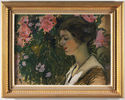
19th, 20th & 21st Century Fine Prints
707-546-7352 · fax 707-546-7924 · web: www.annexgalleries.com · email: artannex@aol.com
Jean Georges Cornélius Biography
Jean Georges Cornélius
French
1880–1963
Biography
Painter Jean-Georges Cornélius was born in Strasbourg on January 23, 1880. His family left for Alsace in 1895, and Cornélius entered the studio of Gustave Moreau at age fifteen. Upon Moreau’s death, Cornélius attended the courses of René Ménard and Luc-Olivier Merson, and joined the Académie de la Grande Chaumière where he met young American and fellow student Auria Moses, who he married in 1917. Between 1905 and 1913, he produced a large number of Middle Ages-inspired illustrations for magazines and two major works, including "La Chanson de Roland" in 1912. His style often borrowed from the medieval period, including themes of Christian spirituality.
With the advent of World War I in 1914, he became a nurse in a combat unit, and suffered the loss of an eye as well as other injuries. The effect of the war on Cornélius changed his outlook on creativity, and his style began exhibiting the influences of Symbolism and German Expressionism. He began to exhibit, and would travel to Paris, the United States and Belgium for group and solo shows.
In 1929, he met Georges Bernanos, author and fellow World War I soldier, with whom he became very close and who inspired his 1931 conversion from Protestantism to Catholicism. This conversion also influenced his work, and themes of the holy emerged in many of his paintings.
He received various commissions for illustrations throughout his career, including the 1927 issue of Oscar Wilde’s Le Ballade de la Geole de Reading, using copperplate etchings; and the Editions Colbert issue of Les Fleurs du Mal by Charles Baudelaire in 1951. Cornélius settled in Belgium, then in the Balearic Islands and in Paris, though he frequently returned to his Breton property in Boursoul, as Brittany continued to inspire him and permeated his work. On the advice of Bernanos, the Cornelius family moved to Brazil (where he exhibited) in 1947, then to Rome, before returning definitively to Brittany.
His last exhibition was held in Nantes in 1956. Jean-Georges Cornélius died in Ploubazlanec in 1963. Much of his work fell into obscurity following his death, but in 2007 his daughter donated a major collection of his work to the Heiron Museum of France, and interest grew in the artist once more. In 2019 a retrospective of his works was held at the Sacred Art Museum of Pont-Saint-Espirit.

